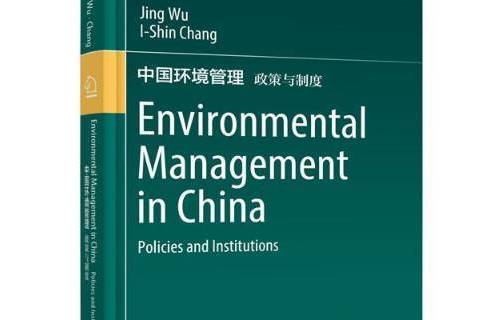《中國環境管理:政策與制度》是2020年化學工業出版社出版的圖書,作者是吳婧、張一心。
基本介紹
- 中文名:中國環境管理:政策與制度
- 作者:吳婧、張一心
- 出版社:化學工業出版社
- 出版時間:2020年
- 開本:16 開
- 裝幀:平裝-膠訂
- ISBN:9787122375889
內容簡介,作者簡介,圖書目錄,
內容簡介
《中國環境管理:政策與制度》(Environmental Management in China:Policies and Institutions)以英文形式全面系統總結了中國當代環境管理政策與制度的發展歷程,生動展現真實、立體的中國環境管理全貌,為推動一帶一路綠色發展傳播中國聲音。全書共19章,第1章是環境管理行政管理的演化;第2章闡述了環境管理指導思想的產生和發展;第3章至第16章介紹我國主要環境管理政策與制度的發展歷程、特點及其成效,包括環境規劃制度、環境影響評價制度、三同時制度、排污收費和環境保護稅制度、環境保護目標責任制、排污許可制度、污染集中控制、總量控制制度、公眾參與制度與環境信息公開制度、生態保護紅線制度、區域聯防聯控、生態環境損害賠償制度、清潔生產制度、生態補償制度等;從第17章到第19章,介紹了我國環境保護在大氣、水和土壤方面的重要任務。*後給出了主要法律、法規、條例、措施等的中英文對照表,以供參考。
本書可供高等院校環境專業作為教材使用,還可供從事環境保護、環境管理等領域的科研人員閱讀參考。
作者簡介
吳婧,南開大學環境科學與工程學院,教授。現任南開大學戰略環境評價研究中心副主任,從事環境政策、環境規劃與管理、環境評價方面的教學、培訓與科研工作。兼任南開大學聯合國教科文組織(UNISPAR/UNESCO)環境管理教席秘書,香港中文大學中國環境戰略研究中心,項目主任 。持有中華人民共和國環境影響評價工程師職業資格證書、中華人民共和國法律職業資格證書、清潔生產審核師證書。全國環境損害司法鑑定機構登記評審專家庫(國家庫)專家。主持國家自然科學基金、國家社科基金重點項目子課題等省部級科研項目和國際合作項目10餘項。
圖書目錄
Chapter 1 Administration on Environmental Management1
1.1 The History of the MEE 1
1.2 Structure and Functions of the MEE 3
Chapter 2 Evolution of China’s Environmental Policy 7
2.1 In the 1970s: The Principles of National Environmental Protection 7
2.2 In the 1980s: The Principles of Three-Simultaneity and Three-Unification 8
2.3 In the 1990s: Sustainable Development 9
2.4 In the 2000s: Scientific Outlook on Development 10
2.5 In the 2010s: Ecological Civilization 12
2.6 Concluding Remarks 14
Reference 15
Chapter 3 Environmental Planning 17
3.1 The Development of Environmental Planning 17
3.2 Environmental Protection and the Plan of National Economic and Social Development 21
3.2.1 Environmental Protection During the 6th FYP (1981–1985) 23
3.2.2 Environmental Protection During the 7th FYP (1986–1990) 24
3.2.3 Environmental Protection During the 8th FYP (1991–1995) 25
3.2.4 Environmental Protection During the 9th FYP (1996–2000) 25
3.2.5 Environmental Protection During the 10th FYP (2001–2005) 26
3.2.6 Environmental Protection During the 11th FYP (2006–2010) 28
3.2.7 Environmental Protection During the 12th FYP (2011–2015) 29
3.2.8 Ecological and Environmental Protection During the 13th FYP (2016–2020) 30
3.3 The Coordination and Integration of Multiple Plans 31
References34
Chapter 4 Environmental Impact Assessment35
4.1 The Concept and Principles of EIA 35
4.2 The Development of EIA Globally 36
4.3 The Development of EIA in China 37
4.3.1 Initial Phase (1973–1978)37
4.3.2 Early Implementation Phase (1979–1989) 37
4.3.3 Improvement Phase (1990–2002) 39
4.3.4 Breakthrough Phase (2003–2014) 41
4.3.5 Reform (2015–Date) 42
4.4 The Legal Framework of EIA in China 43
4.5 EIA for Project (Project EIA) 45
4.5.1 Categorization for Project EIA 46
4.5.2 Process for Project EIA 46
4.5.3 Documentation for Project EIA 46
4.5.4 Public Participation in Project EIA 48
4.5.5 Review and Decision on the EIA Documents 49
4.5.6 EIA Follow-up for Construction Project 52
4.6 Regional EIA (REIA) 53
4.7 EIA for Plan (PEIA)54
4.7.1 Applicable Scope of PEIA 54
4.7.2 Roles and Responsibilities 55
4.7.3 Approaches and Requirements of PEIA56
4.7.4 Public Participation in PEIA 56
4.7.5 Submission and Review of the PEIA Documents 58
4.7.6 Approval of Plan 58
4.7.7 EIA Follow-up for Plan 58
4.8 Certificate System of EIA Consultancy (Revoked in 2018) 59
4.9 Management of Qualified EIA Practitioners 60
4.10 Prospects of EIA in China 61
References 62
Chapter 5 Three Synchronizations System 63
5.1 The Development of the Three Synchronizations System 63
5.2 The Requirements of the Three Synchronizations System 66
5.2.1 Synchronous Design 66
5.2.2 Synchronous Construction 67
5.2.3 Synchronous Operation 67
5.2.4 Roles and Responsibilities 67
5.2.5 The Violation 68
References 68
Chapter 6 Emissions Charges System and Environmental Protection Tax System 69
6.1 Development of the Emissions Charges System69
6.2 The Content of the Emissions Charges System 72
6.2.1 The Payer 72
6.2.2 Category and Amount of Pollutant Emission 72
6.2.3 Category of the Emissions Charges 72
6.2.4 Charge Rates 73
6.2.5 Collection and Utilizations of the Emissions Charges73
6.3 The Environmental Protection Tax System 75
6.3.1 Who Pays the Environmental Protection Tax 80
6.3.2 Items Subject to the Environmental Protection Tax 80
6.3.3 Basis and Rate of the Environmental Protection Tax 82
6.3.4 Preferential Policy83
6.3.5 Monitoring and Enforcement 83
References 84
Chapter 7 Target Responsibility System of Environmental Protection and Performance Evaluation System 85
7.1 The Formation and Development of the Target Responsibility System of Environmental Protection 85
7.2 Targets of Environmental Protection and Indicators Setting 88
7.3 Target Setting88
7.4 Performance Evaluation 88
7.5 Shared Responsibility of Ecological and Environmental Protection for Government and Party 90
7.6 The Audit of Natural Resources Assets for Leading Cadres While Leaving Office 92
References93
Chapter 8 Centralized Pollution Control System 95
8.1 Centralized Heating in Urban Areas 96
8.2 Centralized Pollution Control of Wastewater 97
8.3 Centralized Pollution Control of Municipal Solid Waste 100
8.3.1 Landfill 101
8.3.2 Incineration101
References 103
Chapter 9 Emission Reporting, Registration and Permit System 105
9.1 The Formation and Development of the Emission Permit System 105
9.2 Implementation Process of the Emission Reporting, Registration, and Permit System 108
9.2.1 Reporting and Registering Pollutant Emission108
9.2.2 Verifying Pollutant Emission108
9.2.3 Issuing the Emission Permit 108
9.2.4 Supervision and Management for the Emission Permit 109
9.3 Essentials of the Emission Permit System 109
9.3.1 Who Shall Apply for the Emission Permit 109
9.3.2 An Integrated Emission Permit 109
9.3.3 Procedure to Apply for the Emission Permit 109

